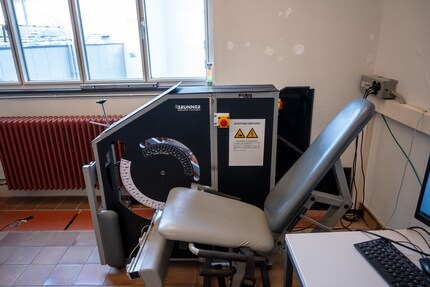
Background information
Why the 10-per-cent rule in jogging is actually wrong
by Siri Schubert

The Swiss Federal Institute of Technology in Zurich (ETH) is researching strength training that can be customised to a person’s physiological characteristics and completed efficiently. I headed over there to try it out.
Strength training is medicine. It’s effective right into our old age and keeps us mobile; and longer-term mobility means a better quality of life. The thing is, strength training also means blood, sweat and tears. Alright, alright, it’s not that dramatic. However, to reap the benefits of strength training in the long run, you need to put in years of consistent work. This not only requires discipline, but also takes up a lot of time. Time that not many of us have.


This is where Dr Claudio Viecelli, a biologist at the Swiss Federal Institute of Technology and guest contributor for Galaxus and his research come in. He and Luca Niederhauser, a Mechanical Engineering student at ETH, have developed control technology for a motorised leg extension that makes high-intensity leg training possible in just a few minutes. The prototype is located at ETH’s headquarters in Zurich’s District 11.

Doing high-intensity training on the prototype, practically all motor units are recruited immediately. During conventional training with, say, 50 per cent of 1-RM (the amount of weight you can lift in one repetition over the complete range of motion, but not doing it a second time), motor units recruit gradually. As a result, the exercises take longer. However, there’s a problem with this; high intensity is associated with low muscle tension duration, as the internal torque has to overcome the external torque. If this stops happening, the exercise inevitably stops. For 85 per cent of 1-RM, this is typically between four and six repetitions.
With their research, Viecelli and Niederhauser aim to find out if they can compensate for the loss of internal torque by reducing external torque in real time, ensuring another rep is always possible over the muscle’s full range of motion. The goal is to increase the effective tension duration, at which all fibre types are fully recruited, to two minutes. This maximises the efficiency of the workout while reducing the duration of the workout. Subsequently, athletes could significantly reduce their training times, allowing more time for recovery and other forms of exercise.

The theory sounds complicated, but it’s actually pretty simple in practice. I got to have a go on the prototype at ETH. This involves having your quadriceps’ 1-RM measured, then training at 85 per cent of this figure on the leg extension. In doing so, you use a drop set, and always train over the muscle’s full range of motion. You’re at muscle failure the whole time, and you feel it from the first repetition. At the same time, the algorithm constantly adjusts the weight and you do as many reps as possible. This takes a maximum of two minutes per leg, at which point, your muscles are wrecked. Murderously efficient. As for a second set, you won’t be willing to do one.


This interdisciplinary research project has seen Claudio Viecelli (a Doctor of Biology) and Luca Niederhauser (a Master’s student of Mechanical Engineering) join forces to research the strength training of the future. Personalisation is seeping into numerous aspects of our everyday lives, such as in personalised medicine, which takes the genome and epigenetics into account.
Gyms, however, are still using standardised training plans (too) often, failing to properly take their users’ individual physiological characteristics into account. This is neither efficient nor effective, especially since most devices are analogue, rendering data acquisition or analysis impossible. At ETH, the leg extension is a first step towards personalised, data-driven workouts. After all, the strength training of the future is personalised and digital. This will allow the science to be mapped into software that analyses exercise and controls the workout in real time, therefore personalising it, contributing to the person’s own goal as much as possible.


Header image: Claudio Viecelli
From radio journalist to product tester and storyteller, jogger to gravel bike novice and fitness enthusiast with barbells and dumbbells. I'm excited to see where the journey'll take me next.
Interesting facts about products, behind-the-scenes looks at manufacturers and deep-dives on interesting people.
Show all